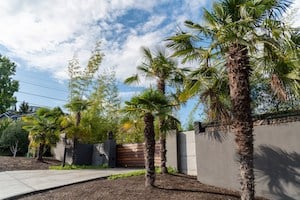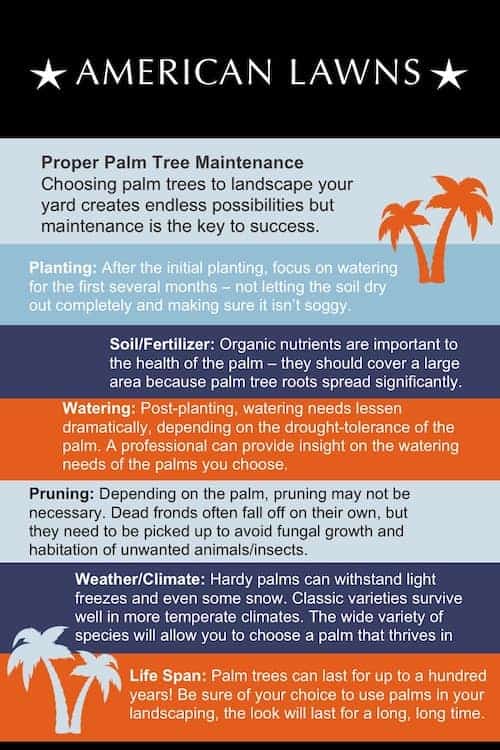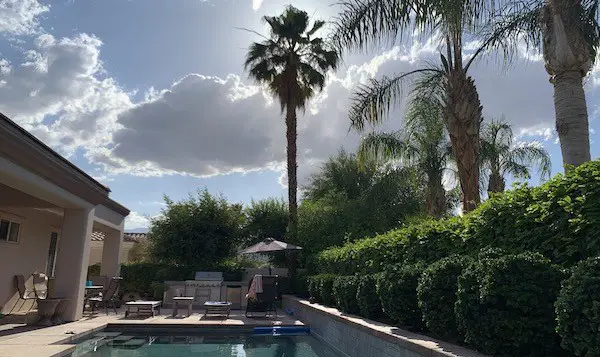The Ultimate Guide to Landscaping with Palm Trees
Are you thinking about adding some palm trees to your landscaping? Looking for the perfect plant to add to your curb appeal? Using palm trees can turn your yard into a paradise – with several different ways to use them. In this article, I’ve done all the research needed to create the ultimate guide for landscaping with palm trees – keep reading to become an expert!
So, what do need to know before you landscape with palm trees? There are a few things you must learn about before landscaping with palm trees including:
- Understanding the basics of palm trees
- Choosing the purpose for using palm trees in your landscaping
- Proper maintenance of palm trees for growth and appearance
It’s always important to have a garden plan before purchasing and planting anything. Reading this guide and consulting with a professional can make your yard the envy of the neighborhood! Get started by understanding the basics of palm trees – this will help you choose the plant you’ve been looking for.
Understanding the Basics of Palm Trees
 Guess what? Palms aren’t actually trees! Instead, a palm is actually a flowering grass-like plant (also known as a monocot). There are many different types to choose from – with different leaves, trunks, heights, growth patterns, etc. The most common question you’ll hear when shopping for palm trees will be “Pinnate or Palmate?”
Guess what? Palms aren’t actually trees! Instead, a palm is actually a flowering grass-like plant (also known as a monocot). There are many different types to choose from – with different leaves, trunks, heights, growth patterns, etc. The most common question you’ll hear when shopping for palm trees will be “Pinnate or Palmate?”
Pinnate vs. Palmate
Palm tree leaves are either pinnate or palmate – referring to the leaves/branches of the tree (also known as the fronds). A pinnate palm tree has leaves that look like feathers, with each leaf growing little leaflets on each side of its stem.
A palmate palm tree has fan-shaped leaves, with leaflets growing from a single shared point at the leaf’s base – this often resembles a fan or the palm of a hand.
Growth Speed
Palms range in size from small bushes, shrubs, and vines, to the giant 200-foot high Quindio Wax Palm. The reputation of palm trees is that they are extremely fast-growing – which is true depending on the type chosen.
Just like other plants, sun, soil, and water are key to palm tree growth. There are specific species that grow much faster than others; a garden professional can help explain this to you when you go to pick out your plant.
You should also note that your palm will likely not reach its maximum growth if you are not living in the warmer parts of the South – but it will gain size at an impressive speed.
Environmental Needs
There are approximately 2,600 species of palms. And among these species are different environmental needs: sun, shade, drought tolerance, winter care, and maintenance requirements. This is why creating a landscaping plan is important prior to the garden creation.
It is especially important to understand the maintenance demands of the palms you choose – it can get expensive and time-consuming. But we’ll learn more about this in the maintenance section later on.
What are the Benefits of Palm Trees?
As was mentioned earlier, having a garden plan is essential before creating your ideal landscape. This plan will explain the look you are going for and what you want from the plants you choose – privacy, shade, cooling, decor/looks, etc.
Because of the many different species of palms, you have a lot to choose from. If you know ahead of time that you are looking for privacy or shade, you will have an easier time deciding on a specific palm. Here are just a few of the many benefits of palm trees:
Privacy
If you’re looking to prevent stares from nosy neighbors, palm trees make excellent barriers with thick trunks and broad leaves. Plant them close together and you’ll soon have a protective wall that keeps out intruders, blocks and absorbs noise, and keeps children and pets inside the perimeter.
Areca Palms: textured fronds that grow densely together and stems that grow up to 30 feet tall. Provide excellent privacy barriers with fluffy, arching leaves.
Shade
Maybe you have a swimming pool in the backyard and you want to avoid the excessive heat in the summer. Planting even just a couple of palm trees around your pool can create the perfect amount of shade for your yard. Now you won’t burn your feet walking around the patio!
Foxtail Palms: grow up to 25 feet with large, fluffy heads of pinnate leaves that grow up to 8-10 feet long. Provide excellent shade coverage.
Cooling
Just like providing the necessary shade, palm trees are great at cooling specific areas in your yard. Choosing a palm tree with a thick canopy and tall height will immediately create a cooler and more relaxing feel.
Cocos/Queen Palms: grow up to 50 feet in height with a wide canopy spread of up to 20-25 feet. Provide excellent shade coverage and immediately cool the area under the canopy.
Decor & Appearance
Instead of having a designated purpose, maybe you just like the look of palm trees and are looking to use them for yard symmetry and an interesting appearance. Line palms along the sides of your pool or frame the front of your house. And, because of the many different species, there are some palms that offer colors other than green too!
Red Latin Palm: bright red leafstalks
Mexican Blue Palm: blueish-grey leaves
 Proper Palm Tree Maintenance
Proper Palm Tree Maintenance
Choosing palm trees to landscape your yard creates endless possibilities. However, maintenance can be daunting depending on which ones you choose. Part of your garden plan should include consulting with a professional on plant location and proximity to your house. Also important are the watering needs, fertilizer/soil types to use, and trimming/pruning when needed.
Largely un-troublesome, palm maintenance varies significantly.
- Planting: After the initial planting, you should focus on watering for the first several months – not letting the soil dry out completely and making sure it isn’t soggy.
- Soil/Fertilizer: Organic nutrients are important to the health of the palm – they should cover a large area because palm tree roots spread significantly. Use mulch around the base of the tree and replace it annually.
- Watering: Post-planting, watering needs lessen dramatically, depending on the drought-tolerance of the palm. A professional can provide insight on the watering needs of the palms you choose.
- Pruning: Depending on the palm, pruning may not be necessary. Dead fronds often fall off on their own, but they need to be picked up to avoid fungal growth and habitation of unwanted animals/insects. Topping palm trees is not recommended. If pruning is necessary – only prune from the bottom and middle fronds.
- Weather/Climate: Hardy palms can withstand light freezes and even some snow. Classic varieties survive well in more temperate climates. The wide variety of species will allow you to choose a palm that thrives in your yard.
- Life Span: Palm trees can last for up to a hundred years! Be sure of your choice to use palms in your landscaping, the look will last for a long, long time.
Related Questions
Can I plant palm trees without living somewhere tropical?
The short answer is yes! Fortunately, you don’t need to be a in India to enjoy palm fronds. As long as you choose a species that survives in colder temperatures or is more drought-tolerant, you can create your own tropical paradise far from the coast. Cabbage Palms and Chinese Fan Palms are good choices for northern climates and Palmettos and Queen Palms are great for more drought-likely climates.
How expensive are palm trees?
As with other trees, the cost will vary depending on the state of the tree when you buy it. If you are buying a fully-grown palm, it will cost more to replant it in your yard than if you were to buy a young, new palm. An average price to remove a palm tree is $200-$1500 depending on the height of the tree – then you have to add the price of replanting.
Purchasing a palm when it is still small, you should expect to pay $15-$45. Purchasing a palm when it is between 4 and 6 feet, expect to pay $145-$325. Purchasing a full-grown palm, expect to pay $500-$2000. All of these prices depend on the species!
How do I cchoose the right palm tree for my yard?
Before choosing the palm, make a plan. You should have a good idea of the look you want and the purpose of the palms. After deciding on a plan, take it to a professional. The professional consultation will help you decide on the best places to plant the palms, the best palms for your location, budget, and needs, as well as what will look best!
Can palm trees be used indoors?
Yes! Because of the large variety of species, there are many different types of palms that can thrive indoors. More good new – they are less high-maintenance than other indoor plant you may have.
Parlor Palm: exhibit an average growth under indoor lighting and do not require much pruning. Flourish in areas of high humidity.
Pygmy Palm: when kept indoors, grow to 3-6 feet. Flourish in areas with a perfect mix of brightness and shade. Avoid overwatering or repotting – these plants have sensitive roots.


